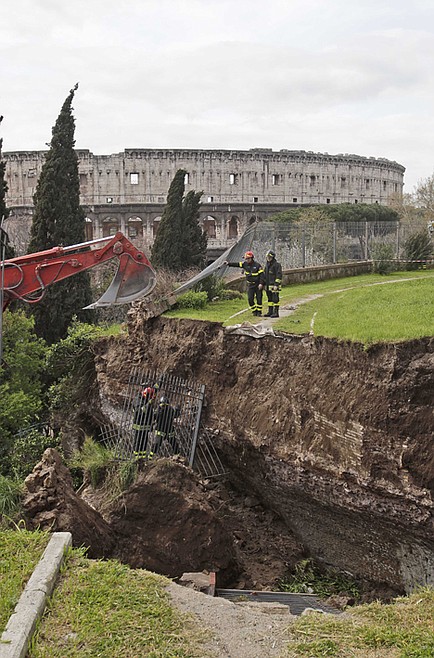Italy falling apart
ROME - For all of Italy's ancient wonders, the real wonder might be that so many are still standing, given the poor care they get.
The collapse in Pompeii last week of a frescoed house where gladiators prepared for combat was the latest loss. The structure had survived the explosion of Mount Vesuvius in 79 A.D. but apparently could not withstand modern neglect.
"We're stunned when some walls fall down. But these are ruins not systematically maintained, so the miracle is that so few of them collapse," said Andrea Carandini, a world-renowned archaeologist who leads a panel of professional consultants in the Cultural Ministry.
Last spring, a huge segment of Nero's fabled Golden Palace beneath Rome gave way, raining down pieces of vaulted ceiling in one of the galleries under a garden popular with strollers. Three years ago, a 20-foot section of ancient wall crumpled into a pile of bricks after days of heavy rain. The wall had been named after the third century emperor Aurelius, who built it to defend Rome against the first onslaught of barbarians.
A couple of months ago, three chunks of mortar broke off the Colosseum, hours before the symbol of the Eternal City opened its gates to tourists.
The ancient Roman arena has survived earthquakes, lightning strikes and pillaging, but these days engineers fret more about damage from pollution, the constant rattling of nearby subway rails and centuries of poor drainage.
Topping experts' list of imperiled structures is Palatine Hill, the once-palatial home of Rome's ancient emperors. For years, archaeologists and engineers have warned that it was at risk of collapse because of poor upkeep.
Fissures are apparent in brickwork, and rainwater seeps through stone, forcing much of the hall to be closed to visitors.
A building called the House of the Chaste Lovers collapsed in January in Pompeii, which is visited by 3 million tourists each year.
"We are tired of commenting on the continuous collapses and damage to the archaeological heritage of our country," said Giorgia Leoni, president of the Italian Confederation of Archaeologists in a statement after the gladiators' place fell apart on Saturday.
On Tuesday, Italian President Giorgio Napolitano decried what he called "terrible negligence" as a chief reason for national embarrassments like the Pompeii collapse.
Carandini, interviewed on Italian radio, warned that, should Pompeii be hard hit by an earthquake, "we wouldn't be able to do a (complete) restoration" because no relief map has ever been made of the site. The Naples area, which hosts the ruins, is one of Italy's most earthquake-prone regions.
Lovers of antiquities have long bemoaned the chronic shortage of funding to shore up shaky structures and save them for posterity.
Italy's Cultural Ministry, which is responsible for repairing ancient monuments and artworks, gets a mere 0.18 percent of the national budget, compared to roughly 1 percent for France, according to ministry officials.
It's a startling contrast for a nation that boasts the world's highest number of ruins, churches, monasteries and other artistic and architectural treasures. Those sites make tourism one of Italy's biggest industries.
Ironically, experts describe Italy as being a leader in preservation for pinpointing possible problems and drawing up a "kind of map of risk."
Giorgio Croci, one of Italy's best-known engineers for structural problems, said the nation's know-how is so in demand that Turkey has commissioned him to study Istanbul's monuments for potential perils.
Greece, with its legacy of ancient marvels, seems to do a better job at keeping their treasures intact.
On the whole, Greek sites have benefited from well-funded restoration and conservation program over the past decades. Although Greece is staggering through a severe economic crisis, work has continued on the Acropolis, where pieces of marble temples and monumental gates have been painstakingly sorted out and reassembled.
That work started after experts realized, in the 1970s, that quick action was needed because of worsening pollution and damage from past restorations.
In Italy, private sponsors, ranging from utility companies to mattress manufacturers, fill some of the gap. But they pick and choose, often "adopting" only the most high-profile projects.
Croci said the Pompeii collapse might have been avoided with simple, affordable measures - such as injecting material to encourage cohesion in the stone or simply covering the structure with some kind of shelter.

